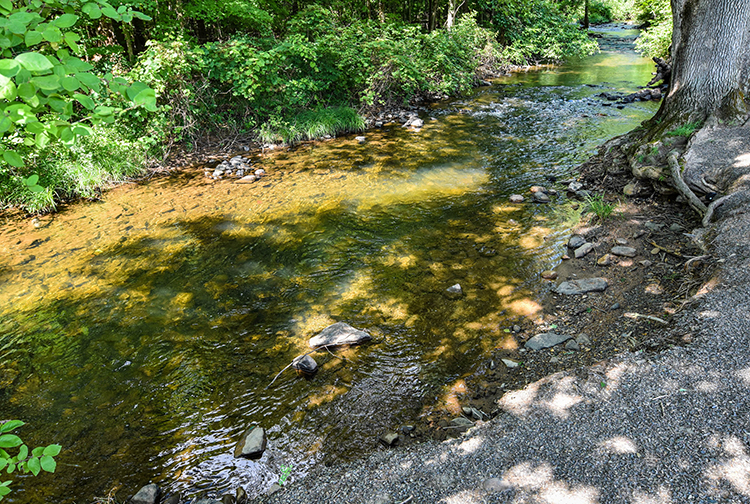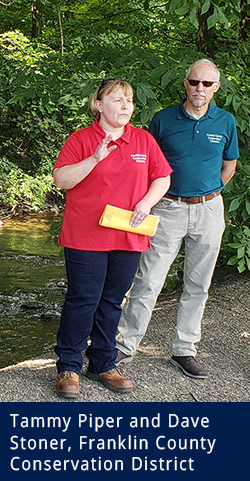Partnerships and funding are key to improving water quality in Franklin County
Residents in Pennsylvania’s part of the Chesapeake Bay watershed—all or part of 43 counties—are working hard to reduce nitrogen and sediment pollution to improve the health of streams and rivers in their communities.
A key component of their effort: Coming together to hammer out a County Action Plan that specifies pollution-reducing actions they’ll take. Each county submits their plan to DEP as part of the state
Phase 3 Watershed Implementation Plan.
These Pennsylvanians are helping their communities in a big way, working to protect public health and water supply; reduce erosion and flooding; and support wildlife, habitat, and outdoor recreation, all of which also have economic impacts.
“Planning” is an inadequate word to describe their endeavor, which requires a combination of teamwork, vision, and passion for community as well as case-making, numbers-crunching, and logistics-nailing. So we want to share an inside look at some of the work these awesome Pennsylvanians are doing in developing their plans, as they strive for healthy local waters and communities.

County: Franklin
Find our County Clean Water Action Plan at: franklinccd.org
Who’s taking the lead in county plan development: Franklin County Planning Commission and Franklin County Conservation District. About 40 local leaders have participated, including folks from the Franklin County Farm Bureau, township supervisors and staff, and other municipal officials.
Healthier streams and rivers mean: Improved plant life, better habitat for fish, and greater opportunities for recreation. Better quality of life for all.
 One thing in our plan we’re especially proud of: The plan presents an opportunity to reinvigorate local watershed organizations and county residents in rallying together to implement the plan’s BMPs (Best Management Practices) to achieve local water quality improvements.
One thing in our plan we’re especially proud of: The plan presents an opportunity to reinvigorate local watershed organizations and county residents in rallying together to implement the plan’s BMPs (Best Management Practices) to achieve local water quality improvements.
Our stakeholder group generated some good ideas along these lines. Discussion is taking place regarding the establishment of a Penn State Extension Franklin County Master Watershed Steward Program, and other organizations can help contribute to this effort. A collaborative effort to promote water resource values, such as a Water Week, or Watershed Snapshots, is another possibility. An education and outreach effort to local municipal officials on stormwater management, open space, etc. and to the agricultural community on best management practices and soil health is being considered.
Main areas we’re focusing our planning on: Our plan development process revealed that agricultural best management practices provide the biggest bang for the buck in reducing nutrients (nitrogen and phosphorus) in streams. Stream restoration projects are excellent opportunities to prevent significant amounts of sediment from eroding into our waterways. Municipal stormwater best practices are more costly to implement and achieve less reduction in nutrient pollution.
Our big pluses: The majority of farmers are currently implementing good stewardship practices. Their use of cover crops, no-till farming, and nutrient management goes a long way in reducing nutrient runoff. There’s still room for improvement, but these practices are increasing along with an effort to increase soil health.
Our top challenges: Uncertainty with regards to current baseline conditions, due to an inferior tracking system for current implementation of best practices. Also the need for funding and technical assistance for best practice implementation—without these, the plan will not be implemented.
We’re thinking outside the box on: Enhanced nutrient management. We're encouraging farmers to adopt the 4R Nutrient Stewardship approach to using fertilizer and nutrients on the fields for crop production: Right Source, Right Rate, Right Time, and Right Place.
The keys to our success will be: We need money, technical assistance, and landowners willing to implement best practices. Partnerships and funding are the keys to improving water quality in Franklin County.
How people can help: Join in the effort of implementing the BMPs identified in the plan. This will improve water quality in the county. Contact the
Franklin County Conservation District office to learn more and get involved.